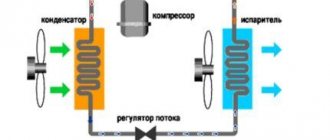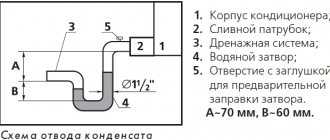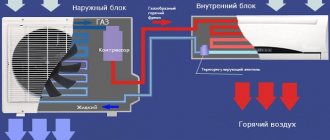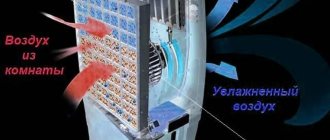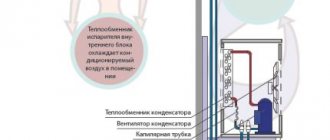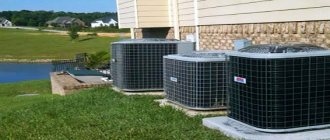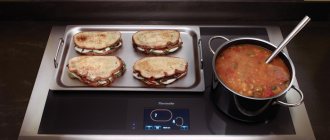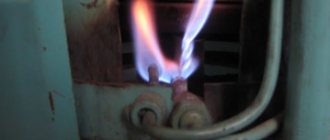If ice has formed on the external unit, then the reasons are as follows:
By the way, there are currently promotions and discounts with the possibility of free installation of an air conditioner, hurry to take advantage!
What to do yourself?
Open the lid of the indoor unit and periodically check to see if there is ice inside. It is also worth carrying out maintenance and cleaning of the air conditioner, as it interacts with the environment, which is full of germs and insects that clog the devices. Air conditioner installation requires constant inspection. Currently, many services offer these procedures. The main thing when choosing is to pay attention to reviews, certificates and qualifications of the master who will do this.
Where and why does the air conditioner freeze?
Frost and ice can cover both the entire outdoor and indoor units, as well as individual parts of the air conditioner: copper tubes with refrigerant, connecting valves, evaporator, condenser, fan, heat exchanger. When internal parts freeze, frost or snow pellets begin to fall directly into the room.
Any of these alarms indicates that the device has experienced a serious malfunction. To prevent it from permanently breaking down, you should immediately disconnect the air conditioner from the power supply by unplugging the plug from the socket.
There are many reasons why your air conditioner freezes. The most common: contamination, moisture penetration, lack/excess of refrigerant, compressor overload, improper installation of the air conditioner. Many of them can be fixed on your own or you can immediately call a specialist.
System clogged
Deposits may appear in the copper tubes of the freon line. They narrow their diameter in certain places, which causes pressure drops. Because of this, frost appears on the evaporator, the load on the compressor increases, and electricity consumption increases. Possible causes of clogged copper pipes of the air conditioner:
- Low-quality freon with foreign impurities is poured;
- Filled with cheap oil;
- Compressor oil mismatch with refrigerant;
- During repair or installation, foreign substances entered the system.
You won’t be able to check the condition of the freon pipeline yourself. You need to call a specialist. If there is a blockage, you can blow out the tubes or replace them with new ones. In this case, you need to replace the old oil and refrigerant.
Why did the air conditioner freeze up after installation or service?
Quite often, customers contact RemBytTech whose split system began to freeze after installation or maintenance (cleaning and refilling freon). It is easy to guess that the reason lies in poor quality of service. The reasons for the formation of ice may be the following.
- Lack of freon . When the hack craftsmen charged the air conditioner not by scale, as it should be, but “by eye”, and as a result, they charged less refrigerant than required for your air conditioner model.
- Installation of the indoor unit in violation of the rules: in a niche, presence of obstacles, etc. The indoor unit cannot be installed in a niche, and there must be enough free space in front of the air conditioner. Otherwise, the air circulates poorly through the split, and the evaporator becomes covered with ice due to poor heat removal.
- Creases on freon pipes . When laying a route, unskilled craftsmen sometimes break the tubes through which the refrigerant circulates. The cross section decreases, the pressure in the system changes. As a result, the air conditioner does not work correctly and the evaporator is filled with ice.
- The tap on the thick tube on the external unit is partially closed . If, after installing or servicing the air conditioner, specialists do not fully open the valve on the suction tube of the outdoor unit, a lack of pressure occurs. Trying to compensate for it, the split works without stopping, which is why the indoor unit is covered with frost and snow.
- Incorrect route length during installation . The length of the route from the internal to the external unit of the air conditioner must fit within the framework recommended by the manufacturer. If the route is shorter or longer than recommended, then the level of refrigerant pressure in the system does not correspond to that specified by the manufacturer. As a result, the air conditioner does not work correctly and freezes.
Incorrect vacuum . If the evacuation is poor, moisture may remain in the cooling circuit. During operation of the air conditioner, it condenses and prevents the normal circulation of freon in the system. As a result, the indoor unit of the air conditioner freezes.
Results
Now you know why your air conditioner may become covered with frost or ice. In some cases, this is absolutely normal, but if water begins to flow down the walls, or ice is clearly visible without removing the decorative cover, then it’s time to sound the alarm.
This situation can only be corrected by an experienced specialist from the service center, so we do not recommend performing repairs yourself. Entrust this task to a professional. He will conduct a complete diagnosis of not only the indoor unit, but also the outdoor unit.
If you have encountered this problem before, please share your experience in the comments below. It will be useful for both users and novice craftsmen. Good luck!
The indoor unit of the air conditioner freezes
The most common causes of freezing of the indoor unit of an air conditioner:
- Air conditioning is used during the cold season. For some models, operation at sub-zero temperatures is not provided. This is especially true for the heating mode.
- Furniture items are too close to the air conditioner and interfere with normal air circulation, creating obstructions. To correct the situation, it is enough to move all the furniture 3 meters or more from the device.
- Compressor overload. They are created not by the constant operation of equipment, but by the failure of the evaporator frost sensors and boards.
- Contamination of parts - filters, evaporator, fan impeller.
- Lack of refrigerant. Refueling will quickly solve this problem.
- Capillary tube clogged. To clean it, you will need a special high-pressure compressor.
- A crease or poor flaring of a thin copper tube. You will have to replace the damaged section or the entire tube.
Clogged filter drier
The filter drier is located between the condenser and the capillary tube. Its task is to draw moisture from the refrigerant and absorb it. It also traps impurities contained in the refrigerant and oil.
A clogged filter drier reduces the system's capacity. Because of this, freon circulates through it more intensively. The evaporator temperature drops and it becomes covered with ice. It is impossible to determine that the filter is clogged without dismantling it.
Important
Whenever working on the freon line, you need to check the condition of the filter drier. If you are refilling, replacing refrigerant or oil, you must change the filter.
b) The heat exchanger of the outdoor unit is dirty.
The external unit of the air conditioner needs to be cleaned. The cost of work is from 900 rubles.
Before you start cleaning the surface, the air conditioner must be disconnected from the power supply. After disconnecting, you need to remove the protective panels of the external unit. Cleaning the external unit of the air conditioner includes several steps:
- Remove any leaves, grass, tree branches or other debris that may be trapped under the protective plates.
- Clean the outdoor unit using a vacuum cleaner and a soft brush.
- Clean the fan blade with a clean and damp cloth. At this point, be as careful as possible so that the electrical connections are not damaged during cleaning.
Polyethylene can be used to protect the electrical components of the outdoor unit from getting wet. It is recommended to clean the radiator fins under running water. Basically, a mini-wash is used to clean the radiator fins. When cleaning, it is necessary to control the pressure of the water jet, since strong pressure may bend the radiator plates.
If some plates are slightly bent, use special plate brushes to straighten them. If there is a high degree of contamination, use a special detergent. Having completely cleaned the external unit, you can begin installing the protective panel.
After washing with special detergents, it is important to wait until the equipment is completely dry, and after a certain time the air conditioner can be connected to the power supply.
What measures to take if ice is found inside the air conditioner?
You assessed the external signs and looked under the air conditioner cover, already expecting to see ice. And if you find it, immediately turn off the equipment. And do not try to carry out repairs yourself - there are too many reasons for ice damming, and they are so diverse that without proper diagnostics (using special equipment and tools), it is not possible to identify the true source of the problems.
Contact specialists. Our technicians solve such problems every day, help clients avoid costly repairs, work promptly and return the equipment to service without extra costs. Immediately after the diagnosis, they will calculate the cost of repairs and continue only with your permission.
Are you looking for specialists who will not deceive you and will solve the problem once and for many years? Contact us! is confident in the qualifications of its employees, therefore it confirms the quality of the work performed and installed spare parts with a 2-year guarantee.
The outdoor unit of the air conditioner freezes
The most common causes of freezing of the outdoor unit of the air conditioner:
- The air conditioner operates in heating mode when the outside air temperature is below 50C.
- Moisture has entered the device. The thin pipe of the air conditioner freezes first, becoming covered with frost or ice. The movement of the refrigerant is hampered and the entire outdoor unit freezes.
- Excess refrigerant. At lower temperatures, less refrigerant is required to operate properly. You need to remove (bleed off) a little freon, and the freezing will stop.
- Contaminated parts, most often covered with dust, freeze the air conditioner heat exchanger. After cleaning it, the device starts working normally.
general information
When users see frost or icing on the indoor unit, they often panic. Still would! Ice forms on the air conditioner right in their apartment or office, and then melts and flows down the walls.
We will surprise you if we say that sometimes a light veil of frost can form when the air conditioner is working normally. Of course, ice and water flowing down the wallpaper do not mean anything good, but light traces of frost do not always signal a breakdown.
Frost may form in the summer if the device is operating at full capacity. Defrosting will begin naturally when you turn off the air conditioner.
Light icing may also occur if you use the air conditioner in heating mode. If the frost is almost invisible and quickly thaws, and the condensate is easily removed through the drainage pipe to the street, then everything is in order and you do not need to worry.
Note! Frost or light icing can only be seen if you open the decorative cover of the indoor unit. In this case, frost forms on the evaporator. If you notice heavy icing and it is noticeable without removing the decorative cover, immediately call a technician from the service center!
What's wrong with the heart?
The main element of any air conditioner is the compressor. He is responsible for compressing freon and pumping it through pipes. The compressor is located in the outdoor unit, on the right side (see figure below). It vibrates a little when working. Place your hand on the block and try to catch the vibration. If it is, then everything is fine with the compressor.
If there is no vibration, this is not a death sentence. Perhaps the compressor is installed on gaskets that dampen vibration. You can check its functionality only by removing the casing of the outdoor unit. Start the air conditioner and let it run for 10-15 minutes. If the compressor is hot, it means it is in working order.
If the compressor remains cold after 15 minutes of operation, there are two options:
- The compressor is not receiving power;
- The compressor has failed.
A power cable runs from the indoor unit to the outdoor unit. Check if there is voltage at the terminals connecting to the compressor. If it is, look for a repairman. If there is no voltage, check it from the indoor unit.
If there is current on the part of the cable that is connected to the boards in the indoor unit, the power cable is broken or burned out. Replacing it will solve the problem. If it is not there, the problem is on the board. Most likely the transformer has burned out. But diagnostics and repairs must be performed by a specialist .
Internal structure of the outdoor unit of the air conditioner.
Sensor (thermistor) failure
The temperature sensor in the split system regulates its operation. In inverter versions, it affects the speed of the compressor; in conventional ones, it affects the frequency and duration of its activation. In different air conditioner models there can be from 2 to 5 in each block. They measure temperature:
- Refrigerant;
- Air;
- Fan electric motors;
- Evaporator;
- Capacitor;
- Outside air;
- Compressor;
- Freon line.
To check the condition and performance of the sensors yourself, you need to measure their resistance at different temperatures. It must correspond to what is specified in the documentation. If there is no such data, you will have to look for the characteristics of the thermistor of the same model. You can also focus on similar air conditioners in the model range.
If you do not understand electronics and the workings of an air conditioner, it is better to call a professional. Checking temperature sensors is quite a troublesome task. A small mistake will result in unwanted costs for a new sensor.
Freon deficiency
In most cases, the refrigerant in climate control devices is freon. It is this that ensures a change in the air temperature in the room and prevents the external unit from freezing. However, we must not forget that it tends to leak over time. As a rule, a working split system loses 6-8 percent of freon per year, but if operating rules are violated, this number can be exceeded several times. So in any case, all climate control equipment needs to be refueled. In any case, the user will not be able to replenish the freon leak on his own, so he will have to call specialists. It is worth noting that the level of freon absence at which the external unit begins to freeze is different for each model. So you need to carefully monitor the device, especially in the cold season.
Source
Service Masters
Send new questions to .
Panasonic split system: when turned on, it immediately turns off and the yellow LED starts blinking
2019-06-04 17:02
Panasonic nine split system: when turned on, it immediately turns off and the yellow LED starts blinking. What to do?
Flashing yellow LED may indicate three types of malfunctions:
- Refrigerant leak.
- The sensors (thermistors) of the indoor unit are faulty.
- The Hall sensor of the indoor unit motor is faulty.
Each of the three options has its own LED blinking algorithm.
Why does the air conditioner freeze and how can you solve this problem?
In the modern world, air conditioning is a common device that allows you to maintain the required temperature in a room without any extra effort. It is especially useful in the summer, when it is very hot outside, and you want to create a cool, favorable atmosphere at home. But when using an air conditioner, various problems often arise. Sometimes the air conditioner may simply not turn on or, for example, make excessive noise. In addition, quite often owners of such climate control equipment are faced with the fact that the external or internal unit of the system freezes.
How to prevent freezing
Avoid making common mistakes when operating your air conditioner:
- observe the temperature regime recommended by the manufacturer for the operation of a particular model,
- Do not turn on the air conditioner on strong cooling if the room humidity is high (this will lead to the formation of excessive condensation and the appearance of a crust of ice on the evaporator).
It is the violation of these prohibitions that leads to the formation of ice inside the air conditioner. This is the most common reason. Therefore, experts never tire of repeating: use the equipment in accordance with the instructions, study it carefully as soon as you install the new air conditioner.
